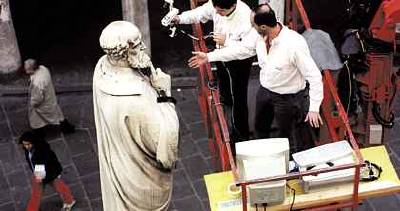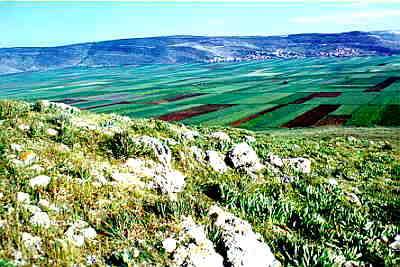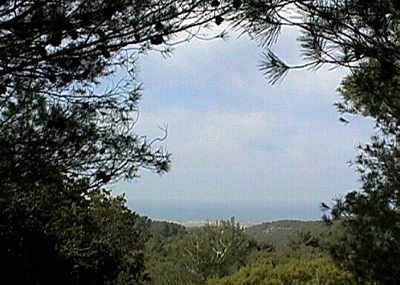 An Italian firm of CAD/CAM specialists have derived unexpected benefits by drawing on a heavyweight cultural icons special to their particular region.
An Italian firm of CAD/CAM specialists have derived unexpected benefits by drawing on a heavyweight cultural icons special to their particular region.
The area around Vicenza in the north of Italy is teeming with all kinds of manufacturing business. Italian goods from this region are world-famous for their style and exceptional quality. UnoCAD s.r.l. supports the region’s designers and manufacturers with reverse engineering, rapid prototyping and a complete range of CAD/CAM solutions.
UnoCAD is unlike the typical service business keeps its experience and toolset behind closed doors. In fact UnoCAD’s many customers often contract the firm on specific projects to prove the available technology and develop the required systems. If the trial project is successful UnoCAD then assists its customer to implement the successful solution in-house, providing hardware, software, training and support as required. By all accounts this holistic approach to problem-solving and building business relationships working very well for all concerned and business is booming.
In an exercise to try out some new technologies and build a little self-promotion in the process, UnoCAD decided to apply the full force of its digital engineering skill to some subjects of local significance and historical importance. It was decided that the team would create digital models of prominent real-life objects, manipulate the data as required, and finally reproduce these objects in a variety of different forms and sizes.
One of the subjects chosen for digital reproduction was the statue of Andrea Palladio that stands in Piazza Signori. The statue is adjacent to Basilica Palladiana (or Palazzo della Ragione), the exterior of which was Palladio’s first major commission. This building, piazza and statue is in the center of the old city of Vicenza, just to the south of the main street, Corso Andrea Palladio. It’s not difficult to get the impression that Palladio is a popular boy in these parts.
The statue stands around 4 meters high on top of a 3 meter plinth and is positioned in an open public place. The importance of the subject and the statue itself meant that only non-contact digitizing could be employed.
The entire statue was digitized using a Polhemus hand-held laser scanner. 3D laser scanning is the most appropriate technology for digitizing a large, complex sculptured form. This scanner can capture 3D data in chunks of about 1.2 meters (4 foot) cubed. A mobile “cherry-picker” was used to get up high and all over the statue, without actually touching it or needing to build any access structure around it. The process allowed scanning to be completed in less than a day. The regular geometry of the plinth meant that it could simply be measured traditionally (with a tape measure) and modeled in a 3D CAD program (UnoCAD used CADKEY) back at the office.
Laser scanning is fast, easy and accurate, however it generates enormous sets of point data. These “point clouds” always need some kind of intelligent manipulation. Not all the points gathered are necessary in order to define the model with sufficient accuracy. Unnecessary points are weeded out by automatic and manual methods in order to reduce the file size for faster processing and provide just enough detail appropriate to the intended end use. Weeding point data files is a process that can be done using automated routines. However, the final pass is usually done manually and requires an experienced person to make significant file size reductions and at the same time maintain model accuracy. This is one area of CAD that really does require a high level of skill that can only be acquired with time and a lot of practice. The best results will have the smallest possible filesize (which will result in faster processing in later stages) for a given level of accuracy. The level of accuracy required is dependent on the ultimate proposed use of the model data and the production technologies that will be employed to make it a physical reality.
 Where the scanned object was bigger than the capacity of the scanner, the component scans are “stitched” (combined) together to form a full model or the scanned space. Any additional regular 3D geometry (such as the plinth) is added at this stage to create a full digital model.
Where the scanned object was bigger than the capacity of the scanner, the component scans are “stitched” (combined) together to form a full model or the scanned space. Any additional regular 3D geometry (such as the plinth) is added at this stage to create a full digital model.
The process of scanning, assembling and cleaning up the data sounds easy fast. It is true that this high tech solution is much faster than using traditional measurement techniques. The absence of any tactile requirement is a bonus that is especially important when dealing with fragile or valuable subjects. The owners of many such subjects would be very reluctant to allow tactile access to historic works of art for any purpose. Like every craft however, there is a measure of skill and experience that makes a vast difference to the final result. Knowledge and experience is essential in every aspect of the process from gathering digital data, editing point data and finishing the final 3D model.
Small-scale reproduction of Andrea Palladio Small-scale reproduction of Andrea Palladio (approx. 200mm high) surrounded by other models produced by the Z402 3D printer.
Once the digital model is complete, it is easy to scale the output to suit any purpose. While visiting the UnoCAD stand at “expo Stampa” in Vicenza I saw a designer modifying a copy of the Palladio model in order to reproduce a statue almost one meter high. The model was to be built on a Z Corporation Z402 3D printer. A very interesting exercise as this 3D printer while more than capable of producing the output, only has an printing capacity of 200x250x200mm (8x10x8 inches). Further more, it was determined that the mass of the upper parts of the model would exceed the structural capacity of the lower parts to hold itself up. Rather than a finely detailed model of the statue, the result could easily be a pile of rubble!
 The solution to the first part of the problem is to section the model into parts that fit within the capacity of the 3D printer. This requires the model to be sectioned into slices. Each section is modified to include jointing details and mating guides that will allow easy and accurate assembly of the resulting sections.
The solution to the first part of the problem is to section the model into parts that fit within the capacity of the 3D printer. This requires the model to be sectioned into slices. Each section is modified to include jointing details and mating guides that will allow easy and accurate assembly of the resulting sections.
The solution to the second part is to “shell” or hollow out the model after it has been scaled to the right dimensions. A shelled model uses less 3D printing medium and results in a lighter, hollow part. A hollow model can also be filled or otherwise reinforced during assembly with a more capable structural core such as resin. In this way the 3D printed surface forms a decorative exterior skin facing concealing a structural resin core. Larger models can be built this way that do not overtax the structural capability of the 3D print medium. The wall thickness just needs to be adequate to accommodate sculptural surface details and strong enough to maintain it’s shape during assembly. The inside is smoothed as not required to match the exterior in detail or form.
 UnoCAD have been able to reproduce the statue in a variety of sizes and materials using a range of CAM output methods. Small models can be produced directly off the Z Corp Z402 3D printer, larger models (even full size) can be machined on large CNC milling machines from (relatively) low cost urethane materials.
UnoCAD have been able to reproduce the statue in a variety of sizes and materials using a range of CAM output methods. Small models can be produced directly off the Z Corp Z402 3D printer, larger models (even full size) can be machined on large CNC milling machines from (relatively) low cost urethane materials.
Winged lion of St Mark This bas-relief winged lion of St Mark also came in for the attention of Unocad’s scanners.
In a parallel project, a bas-relief of the famous winged lion of St Mark was digitized along very similar lines. In this case the output is particularly interesting. While there is nothing unusual about the output technologies used, the final production material is a little unusual. UnoCAD have been able to produce scaled replicas of the lion of St Mark plaque in local Vicenza stone. This is the first time I had ever heard of CNC machining stone, but in Italy at least, the process is not unusual. Even the stone cutting machines are Italian made and are available in large to very large capacities (3x4x1metre – approximately 10x12x3 foot) for anyone wishing to CNC their own monolith. Several Italian manufacturers produce CNC machines capable of machining stone including Brembana Macchine and Bavelloni.
Winged lion of St Mark. The winged lion being cleaned up digitally for reproduction in famous Vicenza stone.
 The spectacular results from these projects have resulted in UnoCAD securing further contracts from communities across Italy to create digital models of precious artworks and structures. In Parma a group of 12th century stone statues will be digitized and reproduced in real stone. The originals, which are currently located in the open air, will be carefully relocated under cover to protect them from the elements. The reproductions will be set in place of the originals. The mayor of Vicenza was so impressed with the winged lion reproductions in miniature that the city has ordered several to be presented as gifts to official visitors to the city.
The spectacular results from these projects have resulted in UnoCAD securing further contracts from communities across Italy to create digital models of precious artworks and structures. In Parma a group of 12th century stone statues will be digitized and reproduced in real stone. The originals, which are currently located in the open air, will be carefully relocated under cover to protect them from the elements. The reproductions will be set in place of the originals. The mayor of Vicenza was so impressed with the winged lion reproductions in miniature that the city has ordered several to be presented as gifts to official visitors to the city.
The city authorities in yet another Italian community (Palermo) have asked UnoCAD to set up the engineering office with the technology and knowledge to create their own digital 3D models in-house. The first project being undertaken in this office is the restoration of an important city fountain, which is deteriorating badly. Engineers will use the 3D model to design a new structural system that will be invisibly incorporated into the original masonry of the fountain. Designing the whole project as a virtual model with high precision allows engineers to consider a range of solutions with a high degree of confidence. Further more components can be prefabricated in advance thus reducing on-site work to a minimum.
From a simple self-promotion exercise UnoCAD has spawned an interesting and profitable business activity. It fits completely within the company’s business and provides valuable experience that benefits all other areas of the company.
Palladio







